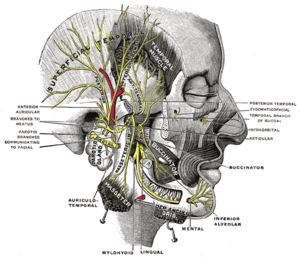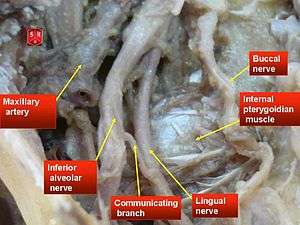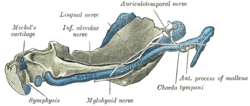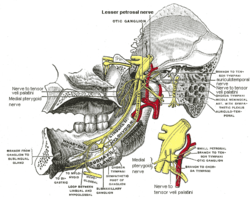Inferior alveolar nerve
The inferior alveolar nerve (sometimes called the inferior dental nerve) is a branch of the mandibular nerve, which is itself the third branch of the trigeminal nerve. The inferior alveolar nerves supply sensation to the lower teeth.
| Inferior alveolar nerve | |
|---|---|
 Distribution of the maxillary and mandibular nerves, and the submaxillary ganglion. (Inferior alveolar visible at center left.) | |
 Mandibular division of the trigeminal nerve. (Inferior alveolar labeled at bottom right.) | |
| Details | |
| From | mandibular nerve |
| To | mylohyoid, dental, incisive, and mental |
| Innervates | dental alveolus |
| Identifiers | |
| Latin | nervus alveolaris inferior |
| TA | A14.2.01.089 |
| FMA | 53243 |
| Anatomical terms of neuroanatomy | |
Structure
The inferior alveolar nerve is a branch of the mandibular nerve. After branching from the mandibular nerve, the inferior alveolar nerve travels behind the lateral pterygoid muscle. It gives off a branch, the mylohyoid nerve, and then enters the mandibular foramen.[1]:543
While in the mandibular canal within the mandible, it supplies the lower teeth (molars and second premolar) with sensory branches that form into the inferior dental plexus and give off small gingival and dental nerves to the teeth.
Anteriorly, the nerve gives off the mental nerve at about the level of the mandibular 2nd premolars, which exits the mandible via the mental foramen and supplies sensory branches to the chin and lower lip.
The inferior alveolar nerve continues anteriorly as the mandibular incisive nerve to innervate the mandibular canines and incisors.
Variation
Rarely, a bifid inferior alveolar nerve may be present, in which case a second mandibular foramen, more inferiorly placed, exists and can be detected by noting a doubled mandibular canal on a radiograph.[2]

Function
The inferior alveolar nerves supply sensation to the lower teeth,[1]:519 and, via the mental nerve, sensation to the chin and lower lip.
The mylohyoid nerve is a motor nerve supplying the mylohyoid and the anterior belly of the digastric.
Clinical significance
Injury
Inferior nerve injury most commonly occurs during surgery including wisdom tooth, dental implant placement in the mandible, root canal treatment where tooth roots are close to the nerve canal in the mandible, deep dental local anaesthetic injections or orthognathic surgery. Trauma and related mandibular fractures are also often related to inferior alveolar nerve injuries.
Trigeminal sensory nerve injuries are associated with numbness, pain, altered sensation and usually a combination of all three.[3] This can result in a significant reduction in quality of life with functional difficulties and psychological impact[4]
The risk associated with wisdom tooth surgery is commonly accepted to be 2% temporary and 0.2% permanent. However, this risk assessment is not concrete as the same source is cited for lingual nerve paresthesia. It is well documented that inferior alveolar nerve injury is more common than lingual nerve injury. The percentage of injury varies significantly in different studies. Furthermore, many factors affect the incidence of nerve injury. For example, the incidence of nerve injury in teens removing third molars is much lower than the incidence in patients 25 and older.[5] This risk increases 10 fold if the tooth is close to the inferior dental canal containing the inferior alveolar nerve (as judged on a dental radiograph).[6] These high risk wisdom teeth can be further assessed using cone beam CT imaging to assess and plan surgery to minimise nerve injury by careful extraction or undertaking a coronectomy procedure in healthy patients with healthy teeth[7]
The risk of nerve injury in relation to mandibular dental implants is not known but it is a recognised risk requiring the patient to be warned.[8] If an injury occurs urgent treatment is required. The risk nerve injury in relation deep dental injections has a risk of injury in approximately 1:14,000 with 25% of these remaining persistent. Routine preoperative warnings about these injuries should occur before surgery, and represent good practice.[9][10]
Anesthesia
During dental procedures, a local nerve block may be applied. Anaesthetic injected near the mandibular foramen to block the inferior alveolar nerve and the nearby lingual nerve (supplying the tongue). This causes loss of sensation on the same side as the block to:
- the teeth (inferior alveolar nerve block)
- the lower lip and chin (mental nerve block)
- front two-thirds of the tongue (lingual nerve block).
Studies found that oral medications of NSAIDs taken before the dental procedure increases the efficacy of the anesthesia in patients with irreversible pulpitis.[11]
Additional images
 Mandible of human embryo 95 mm long. Inner aspect. Nuclei of cartilage stippled.
Mandible of human embryo 95 mm long. Inner aspect. Nuclei of cartilage stippled. Mandibular division of trifacial nerve, seen from the middle line.
Mandibular division of trifacial nerve, seen from the middle line.- Inferior alveolar nerve
- Mandibular nerve and bone. Deep dissection. Anterior view.
- Infratemporal fossa. Lingual and inferior alveolar nerve. Deep dissection. Anterolateral view
References
- Susan Standring, editor-in-chief; section editors, Neil R. Borley; et al., eds. (2008). Gray's Anatomy (40th ed.). Edinburgh: Churchill Livingstone/Elsevier. ISBN 9780808923718.
- Illustrated Anatomy of the Head and Neck, Fehrenbach and Herring, Elsevier, 2012, page 59
- Profiling of patients presenting with post traumatic neuropathy of the trigeminal nerve.Renton T, Yilmaz Z.J Orofac Pain. 2011 Fall;25(4):333-44.
- The psychosocial and affective burden of post traumatic neuropathy following injuries to the trigeminal nerve.Smith JG, Elias LA, Yilmaz Z, Barker S, Shah K, Shah S, Renton T.J Orofac Pain. 2013 Fall;27(4):293-303. doi: 10.11607/jop.1056
- http://www.rcseng.ac.uk/patients/recovering-from-surgery/wisdom-teeth-extraction
- Br J Oral Maxillofac Surg. 2013 Dec;51(8):868-73. doi: 10.1016/j.bjoms.2013.08.007. Epub 2013 Sep 3.Factors that are associated with injury to the inferior alveolar nerve in high-risk patients after removal of third molars.Selvi F1, Dodson TB, Nattestad A, Robertson K, Tolstunov L
- Coronectomy vs. total removal for third molar extraction: a systematic review.Long H, Zhou Y, Liao L, Pyakurel U, Wang Y, Lai W.J Dent Res. 2012 Jul;91(7):659-65. doi: 10.1177/0022034512449346. Epub 2012 May 23. Review
- Post-implant neuropathy of the trigeminal nerve. A case series.Renton T, Dawood A, Shah A, Searson L, Yilmaz Z.Br Dent J. 2012 Jun 8;212(11)
- "Archived copy" (PDF). Archived from the original (PDF) on 2014-04-16. Retrieved 2014-04-15.CS1 maint: archived copy as title (link)
- "Anaesthesia (UK) - Local and General anaesthesia information - Patient". Patient.
- Shantiaee, Yazdan; Javaheri, Sahar; Movahhedian, Amir; Eslami, Sarah; Dianat, Omid (April 2017). "Efficacy of preoperative ibuprofen and meloxicam on the success rate of inferior alveolar nerve block for teeth with irreversible pulpitis". International Dental Journal. 67 (2): 85–90. doi:10.1111/idj.12272. ISSN 1875-595X. PMID 27933616.
External links
- Anatomy figure: 27:03-06 at Human Anatomy Online, SUNY Downstate Medical Center
- MedEd at Loyola GrossAnatomy/h_n/cn/cn1/cnb3.htm
- lesson4 at The Anatomy Lesson by Wesley Norman (Georgetown University) (mandibularnerve)
- cranialnerves at The Anatomy Lesson by Wesley Norman (Georgetown University) (V)